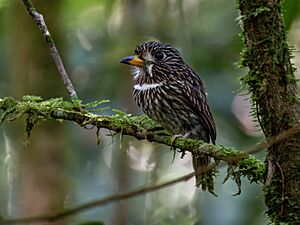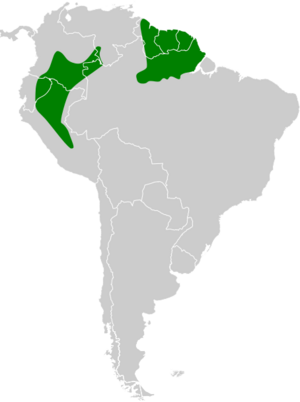White-chested puffbird facts for kids
Quick facts for kids White-chested puffbird |
|
|---|---|
 |
|
| Conservation status | |
| Scientific classification | |
| Genus: |
Malacoptila
|
| Species: |
fusca
|
 |
|
The white-chested puffbird (Malacoptila fusca) is a fascinating bird that lives in the forests of South America. It's part of a bird family called Bucconidae. This family includes puffbirds, nunlets, and nunbirds. These birds are known for sitting very still, almost like they're puffed up, while they wait for their next meal. The white-chested puffbird is one of seven types of birds in its group, called Malacoptila. You can find it in countries like Brazil, Colombia, Ecuador, and Peru.
Contents
About the White-chested Puffbird
How Scientists Name Birds
The white-chested puffbird got its official name in 1788. A German scientist named Johann Friedrich Gmelin described it. He added it to a famous book about nature called Systema Naturae. At first, he put it in a group called Bucco. He gave it the scientific name Bucco fuscus. The word "fuscus" is Latin and means "brown" or "dusky."
Later, in 1841, another scientist named George Robert Gray created a new group just for puffbirds like this one. He called this group Malacoptila. Now, the white-chested puffbird is one of seven species in this group.
For a while, some scientists thought the white-chested puffbird and the semicollared puffbird were the same kind of bird. But now, they are seen as two different, but very similar, species. The white-chested puffbird is usually considered "monotypic." This means it doesn't have different subspecies or types within its own species.
What Does It Look Like?
The white-chested puffbird is about 18 centimeters (7 inches) long. It weighs around 44 grams (1.5 ounces), which is about as much as a few strawberries.
Its head, back, and the top parts of its wings are dark brown. The top of its head is even darker, almost blackish-brown. If you look closely, you might see pale streaks on its feathers. Its tail is a warm brown color.
This bird has a cool white "whisker" mark near its beak and a white chin. It also has a thin white crescent shape across its upper chest. The rest of its belly is a dirty white or light brown color. It has brown streaks and spots there too.
Its beak is yellow-orange with a black tip. Its eyes can be reddish-brown, yellow, or red. Its legs and feet are usually yellow-green or light green.
What Sounds Does It Make?
The white-chested puffbird has a special song. It's a long, musical trill that goes down in pitch. It sounds like "tree'e'e'e'e'e'e'e'e'ew." It also makes calls, like a high, soft whistle that goes down, sounding like "peeww."
Where It Lives and Its Home
The white-chested puffbird lives in two main areas that are not connected. One area stretches from eastern Colombia and southwestern Venezuela. It goes south through eastern Ecuador and central Peru. The other area is in the lower Amazon Basin. This includes countries like the Guianas (French Guiana, Guyana, Suriname) and parts of Brazil.
This bird likes to live in the lower parts of tropical evergreen forests. These are forests where trees stay green all year. It lives in both "terra firme" forests (on higher, dry ground) and "várzea" forests (which flood seasonally). It's a bird that prefers low-lying areas.
You can find it at different heights above sea level. In Venezuela, it lives up to 200 meters (650 feet) high. In Colombia, it can be found up to 600 meters (2,000 feet). In Ecuador, it's usually up to 900 meters (3,000 feet), but sometimes as high as 1,200 meters (4,000 feet). In Peru, it can even live up to 1,500 meters (4,900 feet) high.
How It Behaves
Feeding Habits
The white-chested puffbird is a patient hunter. It usually sits very still on a branch several meters (a few feet) above the ground. It can stay motionless for a long time. Then, it quickly flies out to catch its prey. It might grab an insect from the ground or from plants. After catching its meal, it usually flies to a different branch to eat.
Sometimes, these birds will follow groups of army ants. These ants stir up other insects as they move, making it easier for the puffbird to find food. Scientists don't know all the details of its diet. But it probably eats mostly insects and other small invertebrates (animals without backbones).
Reproduction and Life Cycle
We don't know much about how white-chested puffbirds raise their young. Scientists think they might nest in burrows (holes) in the ground. This is because their close relative, the white-whiskered puffbird, nests this way. More research is needed to learn about their breeding habits.
Conservation Status
The IUCN (International Union for Conservation of Nature) has looked at the white-chested puffbird. They have listed it as a species of "Least Concern." This means it's not currently in danger of disappearing. It lives across a very large area. Even though we don't know the exact number of these birds, scientists believe their population is stable. There are no major threats that have been found for this bird right now.


